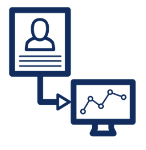What are the best predictive analytics techniques being used today? Let’s explore…Not long ago, underwriters relied on small teams of data analysts to steer decisions. But these techniques took months to complete data collection and processing. They’ve become outdated as the industry faces pressure to meet high approval quotas and even higher customer expectations. Predictive analytic techniques in underwriting have evolved, and with it, underwriters need to meet the ever-changing demands of the insurance industry.
In addition, human error in underwriting has become a prevalent challenge with the pressures of the industry coupled with the rise of online processing. So this brings us to the question(s) many insurers are asking:
What’s the solution? Do underwriters need improved predictive analytics techniques?
The answer: Absolutely. Equipping our teams with the right analytic tools helps eliminate costly errors in the underwriting process. And as a result, it enables teams to accurately process more applications with straight-through underwriting.
Skip to the Key Takeaways
- What causes human error in underwriting?
- What are the costs of human error?
- Is the future of underwriting fully automated?
- Popular predictive analytics techniques and tools
Need to take a quick step back and learn what predictive analytics is? Check out this article first: What is Predictive Analytics and What Does it Mean for Insurers?
What Causes Human Error in Underwriting?
The biggest mistakes that threaten the underwriting process stem from prejudice, partiality, and invisible bias. Insufficient information and inaccurate assessments also play a role. For instance, when observing underwriters in a study at an insurance company, researchers found a 55% difference of opinion when the same case was assessed for risk. Different judgments bring different, unreliable errors as flawed humans tend to do.
Another cause of human error in underwriting that’s too often overlooked is the factor of fatigue. Whether it’s burnout from the ongoing pandemic, working longer hours to meet growing caseloads, or struggling to keep pace with automated underwriting, underwriters (like much of the post-COVID workforce) are fatigued.
Insurers must find ways to increase productivity to process more information without adding more to the underwriter’s load. But the answer isn’t to change the underwriter; it’s to change the process of underwriting.
What Are The Costs of Human Error?
Sure, nobody’s perfect — most employers know this and use it for growth opportunities. But for insurers, this poses a pretty big problem to the bottom line. Human errors during manual underwriting lead to financial consequences, missed opportunities, and more fraudulent claims leakage down the road. Not including health insurance, the annual cost of insurance fraud is over $40 billion. Of course, not all cases of fraud can be prevented through the underwriting process, but a large portion of them can be.
Is the Future of Underwriting Fully Automated?
According to an SMA report, underwriters handling more complex cases are frustrated by tedious, time-consuming tasks that can be performed by entry-level workers. They’d rather use their expertise for the high-level decision-making they’ve been trained for. With this in mind, we need to consider automating these lower-level tasks to free up time for underwriters to spend their expertise on more complex cases.
We believe these lower-level tasks — like initial risk assessments, manual processing, and data collection — can be fully automated with AI and underwriting. If carriers practice ethical AI, intrinsic bias from human error can be drastically reduced. For instance, with companies like ForMotiv where zero PII is collected, insurers can reduce bias’ found in human error and lower the burnout rate. So while time-consuming tasks are being automated, underwriters can delegate their time to more complex cases while also reducing the rate of human error.
Popular Predictive Analytics Techniques Tools: Use Cases, Pros, and Cons
It’s really quite simple — when underwriters have access to intuitive data, they can make more accurate assessments. Here are five popular predictive analytics techniques and tools we’ve seen on the market lately.
SAP Analytics Cloud
This is a cloud solution that combines business intelligence, predictive analytics, and planning capabilities all in one place. They market themselves as the analytics layer of SAP’s Business Technology Platform to offer services that are company-wide.
Use cases: Predictive planning and forecasting, integrated financial planning, company-wide collaboration.
Pros: This tool can benefit multiple departments in a company, not only underwriters. There’s also a trial run option to try everything out before you make any purchases.
Cons: It’s an advanced system, so new customers may need to spend a significant time learning how to use the platform with video training and in-house certifications. And while it’s a cool option that it can be used enterprise-wide, this also means that it’s not tailored to underwriters in insurance.
Cost: $36.00 / month (per user)
RapidMiner
Rapid Miner is an end-to-end science data provider that offers data prep for building machine learning systems, automated machine learning models, and model operations for prescriptive analytics. It services a variety of industries, from automotive all the way to utilities.
Use cases: Churn prevention, fraud detection, risk management.
Pros: It’s a widely used and trusted software in many industries.
Cons: Since it’s not created specifically for insurers, it’s not tailored for underwriters — they’d likely need a data analyst or scientist on their team.
Cost: $625 / month
IBM SPSS
IBM®’s SPSS® software specializes in statistical analysis, machine learning, text analysis, open-source extensibility, and big data integration.
Use cases: Data fabric, management, integration and governance, business analytics, customer care, artificial intelligence.
Pros: As a product of IBM®, this software is protected by their years of business leadership and data development.
Cons: This platform is not easily navigated by someone outside of data analytics. It’s also not specifically geared towards the insurance industry or underwriting department.
Cost: $99 / month (per user)
Alteryx
Alteryx offers various industries data prep and analytics, data science and machine learning, and analytics automation for streamlined data collection. Something unique to this provider is that they aim to drive self-serve business analytics to help make cultural shifts in the associated industry.
Use cases: Internally-facing business analytics.
Pros: Major brands, like Walmart, 7-ELEVEN, and Amway, have trusted Alteryx for data processes.
Cons: While Alteryx can service financial institutions, they don’t specialize in the insurance industry.
Cost: $6,000 / month
ForMotiv
ForMotiv is a first-party intent data collection software that integrates insurance systems with statistic-based algorithms and automated machine learning to identify and predict user behavior.
Use cases: Detect fraud, predict risk, straight-through underwriting, customer experiences, optimize business operations.
Pros: ForMotiv is the only intent data provider that’s tailored to the insurance industry, and as a result, underwriting. It’s the only real-time, first-party behavioral data provider in existence. (Using first-party intent data is important. Here’s why.)
Cons: This software is designed for insurance, banking, and telecom. Industries outside of these can still use ForMotiv, but may not be able to utilize every feature.
Cost: Contact us.
ForMotiv helps carriers expand opportunities for accelerated underwriting and straight-through-processing by predicting user intent — in real-time — to add or remove friction accordingly.
It’s time to get out of the spreadsheets and into an analytics platform with 1st party data. See what ForMotiv can do for your team by booking a free 30 minute demo.





